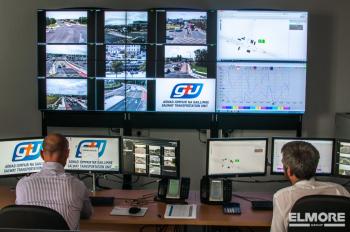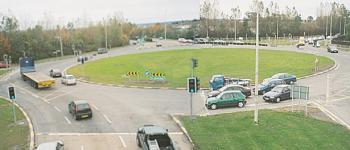Sydney Coordinated Adaptive Traffic System (SCATS) uses a responsive approach to urban traffic control by measuring current conditions and then adjusting Cycle Lengths, Splits and Offsets. It’s real-time response to ever changing traffic conditions ensures the most appropriate traffic signal phasing to safely direct traffic through intersections.
Using sensors implanted in the roadway, and by sending instructions to traffic signal controllers to direct signal phasing, SCATS automatically maximises traffic throughput, minimises delays, and minimises the number of stops en route.
SCATS does not require operator intervention for its day-to-day operation. However, operators have instant access to road information enabling fast response times to solve traffic problems. Developed in Sydney, Australia by the Roads and Traffic Authority of New South Wales (RTA), this Windows NT-based solution employs a very sophisticated and easy-to-use interface. In conjunction with Tyco Traffic & Transportation we can supply, support, and implement the SCATS system, as well as provide comprehensive training.
Adaptive
SCATS adapts itself to the demands of ever changing traffic flows. For instance, it can adapt a strategy to clear sudden and unpredictable traffic loads such as sports and concert event audiences. It also monitors the gradual daily changes that occur with the onset and finish of peak periods, continuously adjusting traffic signal controllers to optimise flow.
One of the principal purposes of SCATS is to provide automatic coordination between traffic signals, thus ensuring minimum overall stops and delays for road users. When an incident occurs that could restrict traffic flow, SCATS automatically determines the best response for that situation.
At the Traffic Management Centre, operations staff are responsible for monitoring the overall system. They observe traffic flow using SCATS software and – under exceptional circumstances – can manually override traffic signals to alter traffic flow.
Flexible
SCATS is flexible in many ways:
-
It’s design allows for easy expansion – whether that be modular or incremental.
-
Other Intelligent Transport Systems (ITS) integrate into SCATS with ease.
-
Allows for part or all of the system to operate on fixed time plans, while a larger or smaller part of the system can operate under an adoptive control plan.
-
With such flexibility and modularity SCATS keeps up with the ever changing traffic requirements of a town or city.
Fail-safe
Should communications be lost between SCATS and a traffic signal controller, a comprehensive fall back plan ensures the coordinated control of surrounding intersections.
Cost-effective
Using SCATS can reduce operational costs because it is self-calibrating, and it does not require on-going traffic surveys and manual creation of plans to ensure optimum traffic flow. Additionally, technical specialists are not required to maintain the system.













